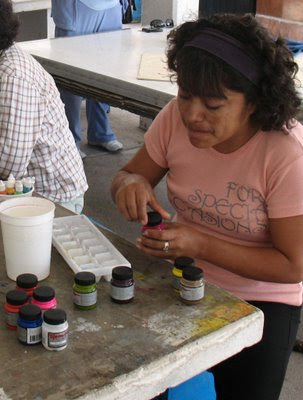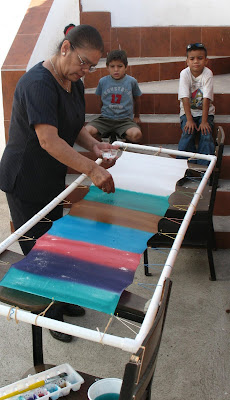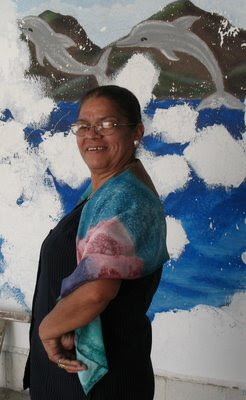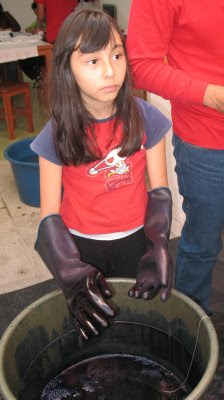I love receiving my monthly online newsletter from Dharma Trading Company, my fabulous supply house for most of what I use in my work. They always have a "featured artist" section which I consistently peruse for new and interesting ideas and connections. February 2008 had one artist by the name of "Silkpainting in Haiti" which caught my attention instantly. Simply put, this is an economic development project in rural Haiti which I believe started out as a silkpainting project about 10 years ago. Visit their site, artmatenwa.org, for an inspirational view of a successful creative endeavor in a third world country.
From that site, I got the idea to try to bring a bit of silk painting to our women of Mujeres Trabajadores, not necessarily to start another offshoot of their already busy sewing industry, but as something to broaden their creative perspectives. But a silk painter I WAS NOT, so I called upon my silk mentor Christine for bits of advice, ordered a dvd by Jill Kennedy, and along with a stack of silk scarves, I dabbled in silk throughout the summer to at least get a bit of a handle on this craft. Before traveling to Mazatlan this November, I ordered 30 habatoi silk scarves and a Dye-na-flow class kit from Dharma to put in my suitcase for a silkpainting class with the women.
That class happened two Mondays ago, as a demo to the group of 12, with plans to then have them sign up in groups of 4 to try their hands at silkpainting. Last Monday saw the first group at work. Here they are, step- by-step demonstrating the fun and simple craft of silkpainting with Dye-na-flow paints.
Step 1- Stretch the silk onto a frame. We used simple PVC frames with rubber bands and pins to hold the silk. Ceci, Mary and Sylvia are working together to secure the silk for painting.

Step 2 -Select your colors. With a design in her mind, Mary is selecting the colors she will use, putting 5 droppers of each into an ice cube tray. The Dye-na-flow paints seem to go a long way.

Step - Paint your silk. Silvia is carefully applying her colors in stripes.

Step 4 - Sprinkle salt or sugar on the wet silk for beautiful texture. Irma is adding silk to hers, with an interested audience looking on.

Step 5-Set the color with a hot dry iron. Ceci shows us how!

Step 6 - Rinse the silk. After ironing, Irma rinses the silk, making sure that any residual color or sugar/salt is removed. Then she ironed again for the final step.

And finally, here are the beautiful silkpainters, modeling their creations:
Irma- she is the bag queen! She makes terrific purses, satchels and bags that are popular in sales. She is a strong member of this group.

Mary is the newest member of the group. I have only known her since December. She seems very focused and organized, coming weekly with her notebook for taking notes, taking measurements for patterns, etc.. Last week, she brought her 12 year old daughter along (no school that day) who then became our helper. Mary makes sure her daughter comes to the community center for extra help in English. I believe she knows the importance of grasping opportunities.

Ceci is a true artist. She is not afraid to try her hand at some type of artistic embellishment on her sewing products. And oh, how she can sing!

Sylvia is an energetic, happy sprite of a woman. She is a good sewer and adds much energy to the group. This year she is in charge of scheduling sales venues and organizing the sales staff.

I was so impressed with how quickly they picked up on the process. After the one demo two weeks ago, they jumped in and barely needed any direction.
Plans are to continue with all the women on painting one scarf, then to try another using gutta resist. We'll see how it goes and I'll report in April on the results.

